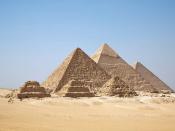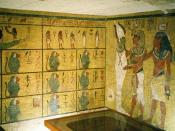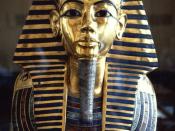In 1920 Howard Carter discovered what was to be one of the most significant archaeology finds of our time the tomb of King Tutancamun.
After opening a small hole in the doorway of the stone entrance to the tomb, Carters first sight was that of two strange ebony black effigies of a king, gold sandaled, bearing staff and mace, loomed out from the cloak of darkness; painted inlaid, and ornamental caskets, flowers, alabaster vases some beautifully executed of lotus and papyrus device, strange black shrines with a gilded monster snake appearing from within, quite ordinary looking white chests finely carved chairs, a golden inlaid throne a heap of large curious white ouiform boxes; a lotiform wishing cup in translucent alabaster, stools of all shapes and design of both common and rare materials and parts of chariots glinting with gold SEE PICTURE BELOW This was called the antechamber. After the antechamber the next room was the burial chamber on Nov 17th Carter made a hole large enough to see into the chamber an astonishing sight was revealed stretching as far as the eye could see was a solid wall of gold.
SEE PICTURE Almost the entire chamber was filled with an enormous shrine, constructed of gessoed cedar covered with sheet gold inlaid with blue faience, measuring seventeen feet by eleven feet.
The walls of the chamber had been coated with a gypsum plaster and painted yellow, with the exception of a dado, painted white and were covered with funereal scenes painted in the amarnan style, a manner different from any others found in the valley of the kings.
RECONSTRUCTED SAMPLES ARE SHOWN BELOW The west wall was the focus of the burial chamber. The upper register is occupied by the solar barque (boat) Below squal 12 baboon dieties of the first...


